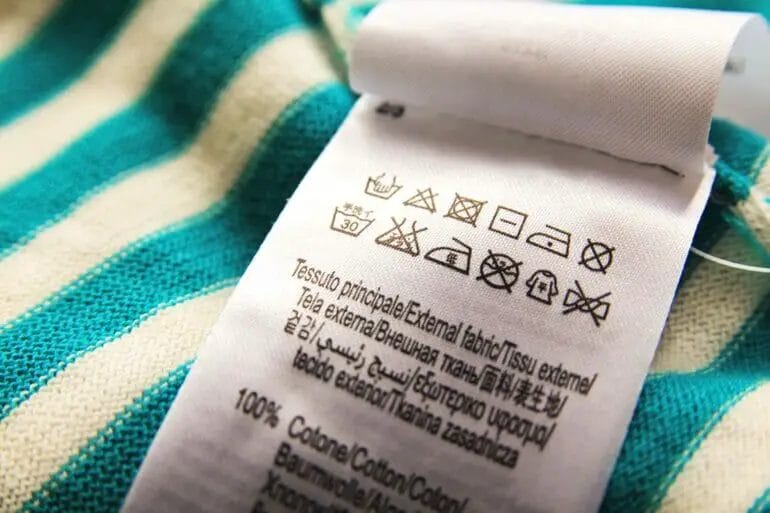Washing a 100% acrylic blanket can be a straightforward process, ensuring that it remains soft, clean, and in good condition for years to come.
First, check the care instructions provided by the manufacturer to ensure you follow any specific guidelines. Generally, machine washing on a gentle cycle with lukewarm water is recommended.
Use a mild detergent and avoid using bleach or harsh chemicals, as they can damage the fibers. It is also advisable to place the blanket in a mesh laundry bag to protect it during the wash.
After the wash cycle is complete, gently squeeze out excess water, but avoid wringing or twisting the blanket, as this can cause stretching and damage.
Finally, carefully hang the blanket to air dry or lay it flat on a clean surface, away from direct sunlight or heat sources. With proper care, your acrylic blanket will remain soft, cozy, and ready to keep you warm.

Choosing the Right Washing Method for Your Acrylic Blanket
Acrylic blankets are a popular choice for their softness, durability, and affordability. Whether you have a cozy acrylic throw or a warm acrylic blanket for your bed, it’s essential to know how to properly clean and care for them to maintain their quality and prolong their lifespan. In this section, we will guide you through the process of choosing the right washing method for your acrylic blanket.
1. Check the Care Instructions
Before you start cleaning your acrylic blanket, always check the care label or manufacturer’s instructions. The care label provides specific guidelines on how to wash and care for your blanket, including recommended water temperature, detergent type, and any special instructions. Following these instructions will help prevent any damage to your acrylic blanket.
2. Determine if Hand Washing or Machine Washing is Suitable
Depending on the size and condition of your acrylic blanket, you can choose between hand washing or machine washing. Hand washing is usually the gentler option and is recommended for delicate or heavily soiled blankets. Machine washing, on the other hand, is more convenient for regular cleaning.
Hand Washing Method:
- Fill a basin or sink with lukewarm water and add a small amount of mild detergent.
- Submerge the acrylic blanket in the water and gently agitate it for a few minutes.
- Rinse the blanket thoroughly with cool water until all the detergent is removed.
- Press the blanket gently to remove excess water. Avoid wringing or twisting, as this can stretch or damage the fibers.
- Place the blanket on a clean towel and roll it up to remove remaining moisture.
- Unroll the blanket and lay it flat on a drying rack or a clean surface to air dry.
Machine Washing Method:
- Place your acrylic blanket in the washing machine and add a mild detergent.
- Set the washing machine to a gentle or delicate cycle with cold water.
- Avoid using bleach or harsh chemicals, as they can damage the fibers of the blanket.
- Once the washing cycle is complete, remove the blanket from the machine.
- Press the blanket gently to remove excess water. Again, avoid wringing or twisting.
- Follow the instructions on the care label for drying, either air drying or tumble drying on low heat.
3. Handling Stains
If your acrylic blanket has stains, it’s important to treat them before washing. Here are some tips on how to handle common stains:
- For food or beverage stains, gently blot the stain with a clean cloth or sponge soaked in a mixture of water and mild detergent.
- For oil-based stains, sprinkle some baking soda or cornstarch on the stain and let it sit for a few hours before brushing it off and washing as usual.
- For tougher stains, you may need to use a stain remover specifically designed for acrylic fabrics. Follow the instructions on the stain remover before washing.
4. Drying and Storage
Proper drying and storage are essential to maintain the quality of your acrylic blanket:
- After washing, gently reshape the blanket to its original size and shape while it is still damp.
- Avoid hanging your acrylic blanket to dry, as it may stretch the fibers. Instead, lay it flat on a drying rack or a clean surface.
- If using a dryer, set it on a low heat or delicate setting to prevent damage.
- Once dry, fold your acrylic blanket neatly and store it in a cool, dry place away from direct sunlight to prevent discoloration or fading.
In summary, properly washing your acrylic blanket is crucial for preserving its softness and longevity. Always check the care instructions, choose the appropriate washing method, handle stains before washing, and ensure proper drying and storage. By following these steps, you can keep your acrylic blanket clean and cozy for years to come.

Tips for Hand Washing Your Acrylic Blanket
Acrylic blankets are a popular choice for their softness, warmth, and durability. However, they require proper care and maintenance to ensure their longevity. While machine washing may seem convenient, hand washing is often recommended to protect the delicate fibers and maintain the blanket’s quality. Follow these tips to effectively hand wash your acrylic blanket:
Gather the Materials
Before you begin, gather the necessary materials for hand washing your acrylic blanket. You will need a mild detergent, a clean basin or sink, lukewarm water, and a soft brush or sponge.
Prepare the Washing Area
Choose a spacious and clean area where you can comfortably wash your blanket. Clear the space and ensure there are no sharp objects or surfaces that could cause damage to the fabric.
Fill the Sink or Basin
Fill the sink or basin with lukewarm water. Avoid using hot water, as it can cause the acrylic fibers to lose their shape and soften too much.
Add Detergent
Add a small amount of mild detergent to the water. Avoid using harsh chemicals or bleach, as they can damage the acrylic fibers. Gently mix the detergent into the water until it is well-dissolved.
Submerge the Blanket
Carefully submerge the acrylic blanket into the water, allowing it to soak for a few minutes. Gently swirl the blanket around to ensure that every part is evenly saturated with the soapy water.
Spot Clean if Needed
If there are any stubborn stains or soiled areas on the blanket, use a soft brush or sponge to gently scrub the affected areas. Avoid rubbing or scrubbing too vigorously, as this can cause pilling or damage to the fabric.
Rinse Thoroughly
Drain the soapy water from the sink or basin and refill it with clean lukewarm water. Rinse the blanket thoroughly, gently squeezing out any excess water. Repeat the rinsing process until the water runs clear.
Press Out Excess Water
After rinsing, carefully lift the blanket out of the water and press it against the side of the sink or basin to remove excess water. Avoid wringing or twisting the blanket, as this can cause stretching or damage to the fibers.
Allow to Air Dry
Lay the acrylic blanket flat on a clean, dry towel or hang it over a drying rack to air dry. Avoid hanging the blanket in direct sunlight or using a dryer, as high heat can shrink and damage the fibers.
Store Properly
Once the blanket is completely dry, fold it neatly and store it in a cool, dry place. Avoid storing it in plastic bags or airtight containers, as this can trap moisture and lead to mildew or odors.
By following these tips, you can ensure that your acrylic blanket remains clean, soft, and cozy for years to come. Hand washing is a simple and effective way to maintain the quality and appearance of your blanket, keeping it in pristine condition.

Machine Washing Your Acrylic Blanket: Dos and Don’ts
Acrylic blankets are a popular choice for their softness, warmth, and durability. Whether you have a cozy acrylic throw or a larger blanket, it’s important to know the proper way to care for and clean your beloved blanket. While acrylic blankets are generally low maintenance, there are a few dos and don’ts to keep in mind when machine washing them. In this section, we will guide you through the process of machine washing your acrylic blanket to ensure it stays clean and retains its quality.
Do: Check the Care Label
Before tossing your acrylic blanket into the washing machine, always check the care label for specific instructions. The care label will provide you with valuable information, such as the recommended water temperature, washing cycle, and any special considerations. Following the care instructions will help prevent any damage to your blanket and ensure that it maintains its softness and color.
Do: Use a Gentle Cycle
When machine washing your acrylic blanket, it’s best to use a gentle cycle. This will minimize any agitation that could potentially cause pilling or fraying. Set your washing machine to the delicate or gentle cycle option to ensure a thorough yet gentle cleaning process for your blanket.
Do: Use Mild Detergent
Opt for a mild detergent when washing your acrylic blanket. Harsh detergents can strip away the softness and color of the blanket. Look for a detergent that is specifically formulated for delicate fabrics or wool. Avoid using bleach or any fabric softeners, as they can also damage the fibers of your blanket.
Do: Wash with Similar Colors
To prevent color bleeding or transfer, it’s important to wash your acrylic blanket with similar colors. Separating your laundry into color groups will help prevent any unwanted color changes or staining. If your blanket has any bold or vibrant colors, it’s wise to wash it separately for the first few washes to be extra cautious.
Do: Use Cold Water
When it comes to washing acrylic blankets, it’s best to use cold water. Hot water can cause the fibers to shrink or lose their shape. Cold water will help maintain the integrity of the blanket while still effectively removing any dirt or stains. Check the care label to ensure that cold water is recommended for your specific blanket.
Don’t: Overload the Machine
Avoid overloading your washing machine when washing your acrylic blanket. Overcrowding the machine can prevent proper agitation and rinsing, resulting in poor cleaning. Make sure there is enough space for the blanket to move freely in the machine, allowing detergent and water to circulate evenly.
Don’t: Use Fabric Softener
While fabric softeners may be enticing for their fragrance and softening capabilities, it’s best to avoid using them when washing acrylic blankets. Fabric softeners can leave a residue on the fibers, making the blanket less soft and absorbent. Stick to a mild detergent without any fabric softening agents for optimal results.
Don’t: Tumble Dry on High Heat
High heat can cause acrylic blankets to shrink or melt. Instead of tumble drying on high heat, opt for a low or medium heat setting. It’s also advisable to remove the blanket from the dryer while it’s still slightly damp to prevent over-drying, which can lead to static buildup and potential damage to the fibers.
Don’t: Dry Clean
Acrylic blankets typically do not require dry cleaning. The chemicals used in dry cleaning can be too harsh for the delicate fibers of the blanket. Machine washing is usually sufficient for keeping acrylic blankets clean and fresh. However, always refer to the care label for specific instructions regarding dry cleaning.
Summary
Machine washing your acrylic blanket can be a simple and effective way to keep it clean and cozy. Remember to always check the care label for specific instructions and follow the dos and don’ts provided. Use a gentle cycle, mild detergent, and cold water. Avoid overloading the machine, using fabric softener, and tumble drying on high heat. By following these guidelines, you can ensure that your acrylic blanket remains soft, vibrant, and in excellent condition for years to come.
Drying and Storing Your Acrylic Blanket: Best Practices
After enjoying the warmth and comfort of your acrylic blanket, it is essential to properly dry and store it to maintain its quality and prolong its lifespan. Follow these best practices to ensure that your acrylic blanket remains in excellent condition:
1. Air Drying
Avoid using a clothes dryer to dry your acrylic blanket as it can lead to shrinkage and damage the fibers. Instead, opt for air drying by laying it flat on a clean and dry surface. This will allow the blanket to dry evenly and prevent any distortion in its shape.
2. Avoid Sunlight
When drying your acrylic blanket, make sure to keep it away from direct sunlight. Prolonged exposure to sunlight can cause the colors to fade and weaken the fabric. Choose a shaded area or an indoor spot with proper air circulation to ensure a gentle drying process.
3. Gentle Handling
Handle your acrylic blanket with care when moving it from one location to another during the drying process. Avoid wringing or twisting it, as this can stretch the fibers and affect its overall shape. Instead, gently lift and place the blanket to prevent unnecessary strain.
4. Store Clean and Dry
Before storing your acrylic blanket, ensure that it is clean and completely dry. Any moisture trapped in the fibers can lead to mold or mildew growth, causing damage to the blanket. If necessary, spot clean any stains or dirt before storing.
5. Fold or Roll
Consider the available space and personal preference when deciding how to store your acrylic blanket. You can either fold it neatly or roll it up for compact storage. When folding, make sure to avoid sharp creases that could weaken the fibers over time.
6. Use a Storage Bag or Container
To protect your acrylic blanket from dust, pests, and potential damage, consider using a storage bag or a plastic container. Ensure that the storage container is clean, dry, and properly sealed to maintain the blanket’s freshness and prevent any potential damage.
7. Avoid Compression
Avoid placing heavy objects on top of your stored acrylic blanket, as this can compress and flatten the fibers. Over time, this compression can affect the blanket’s loftiness and overall comfort. Store it in a location where it won’t be subjected to excessive weight or pressure.
8. Regularly Air Out
Even when stored properly, it’s important to periodically air out your acrylic blanket to prevent any musty odors or moisture buildup. Every few months, unfold or unroll the blanket and lay it flat in a well-ventilated space for a few hours.
9. Protect from Moths
If you live in an area prone to moth infestation, take additional precautions to protect your acrylic blanket. Use mothballs or cedar chips in the storage container to deter moths from causing any damage to the fibers.
In summary, proper drying and storage practices are vital for maintaining the quality and longevity of your acrylic blanket. By following these best practices, you can ensure that your blanket remains in excellent condition, ready to provide warmth and comfort whenever needed.
FAQs
1. How do I wash a 100% acrylic blanket?
To wash a 100% acrylic blanket, fill a basin or sink with lukewarm water and a mild detergent. Submerge the blanket and gently agitate it for a few minutes. Rinse thoroughly, squeeze out excess water, and then lay it flat to dry. Avoid wringing or hanging the blanket to prevent it from stretching.
2. Can I put my 100% acrylic blanket in the washing machine?
It is generally not recommended to machine wash a 100% acrylic blanket as it can cause damage. However, some acrylic blankets may be safe to wash on a gentle cycle with cold water. Always check the care label on the blanket for specific instructions.
3. Can I use bleach to remove stains from my acrylic blanket?
No, you should avoid using bleach on an acrylic blanket as it can cause discoloration and damage the fibers. Instead, try using a stain remover or gently dabbing the stain with a mixture of mild detergent and water. Always test any cleaning solution on a small, inconspicuous area of the blanket first.
Conclusion
When it comes to washing a 100% acrylic blanket, proper care and attention are crucial. By following the right steps, you can keep your blanket looking fresh and cozy for a long time. Start by checking the care label for any specific instructions. When it’s time to wash, opt for a gentle cycle with cold water and a mild detergent to avoid damaging the fibers. Avoid using bleach or fabric softeners as they can cause discoloration or reduce the softness. After washing, air dry the blanket by laying it flat or hanging it, as heat from the dryer can lead to shrinkage. Regularly washing and maintaining your acrylic blanket will ensure its longevity and keep it in top condition.
